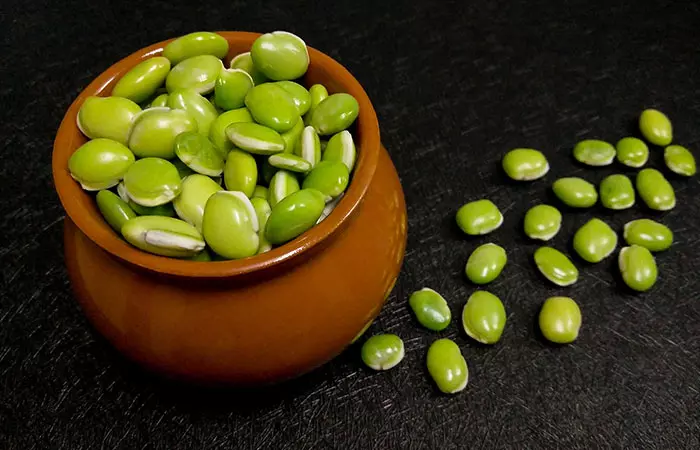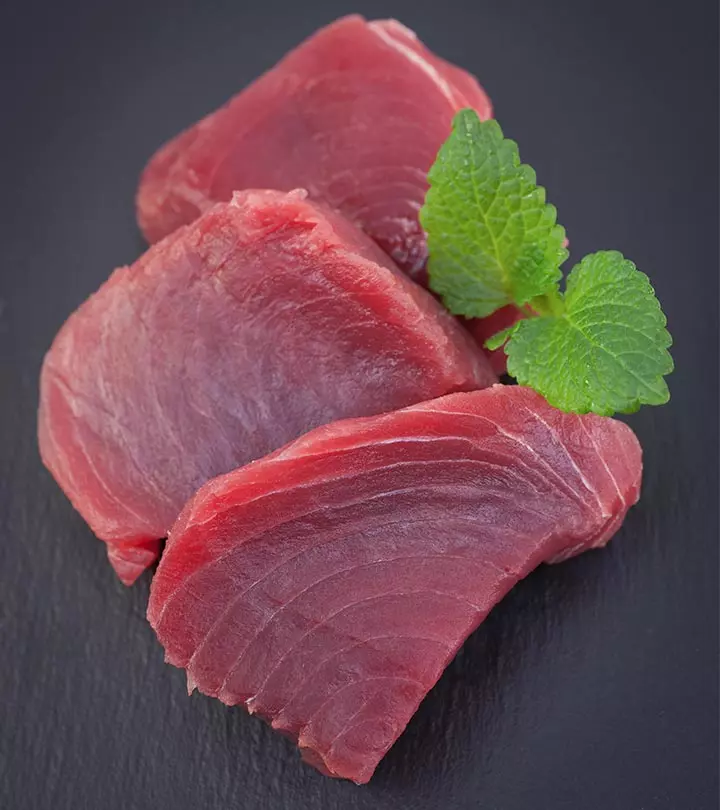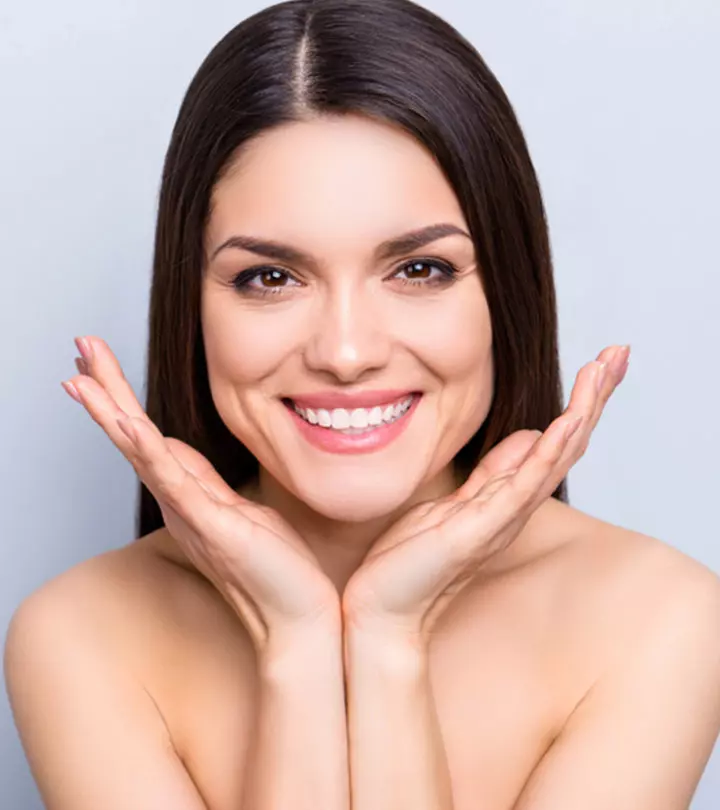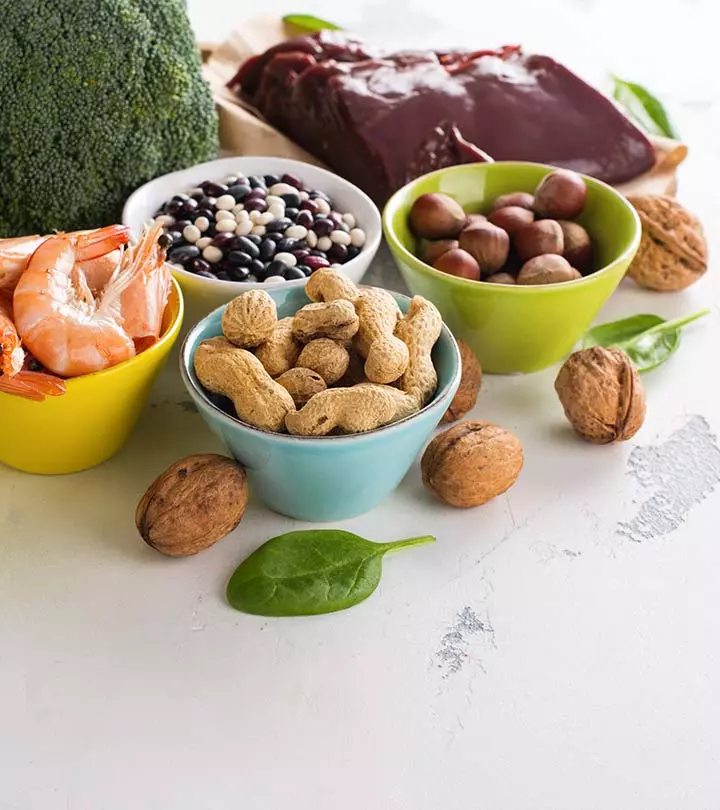Foods Rich In Iodine: 12 Best Sources For Thyroid Health
It's time to add foods like seaweed, cod, shrimp, eggs, tuna, corn, and lima beans to your diet.

Image: Shutterstock
Eating foods rich in iodine is a must. Unfortunately, almost 2 billion people worldwide are deficient in this mineral (1). If not addressed immediately, this deficiency may increase the risk of brain damage and mental retardation, which is not reversible (2).

Iodine is essential for producing thyroid hormones, which are responsible for regulating metabolism and performing many other functions. In adults, its deficiency can result in mental fog and impaired thinking ability. Is there a way out? Yes. Just eating right can help you. In this article, we bring you a list of foods high in iodine. Keep scrolling to check them out!
According to a study, hypothyroidism occurring from iodine deficiency affects about 5% of the US population. The condition is more prevalent in pregnant women belonging to certain subgroups. The study also mentions a survey conducted between 2016-2018 in the UK that revealed about 17% of women aged 16-49 were prone to iodine deficiency disorders.
In This Article
Why Is Iodine Important?
To understand this, we need to look at the functioning of the thyroid gland. This organ is located at the front of the neck, under the voice box. It plays an important role in the metabolism, growth, and development of the human body. The gland achieves this by releasing a steady amount of thyroid hormones (T3 and T4) into the blood.
The thyroid gland needs adequate iodine to function at its optimum levels. Deficiency of iodine can lead to an underactive thyroid, where the gland doesn’t produce enough hormones. This leads to undesirable effects. When the thyroid gland doesn’t receive enough iodine for prolonged periods, it becomes enlarged – in an attempt to compensate for the deficiency. This condition is known as goiter, characterized by an abnormally swollen neck.
 Did You Know?
Did You Know?Shelby Red, a vlogger, shared how consuming iodine supplements for the last 2 years helped manage her hormone issues and improve her overall health. She said, “ I really want to share what helped me and just saved my life really. Saved my health and saved my skin and my and who I am. And just made me smarter. Definitely my IQ has increased by taking iodine (i).”
Iodine benefits the thyroid gland and its deficiency may have negative effects. One way to prevent any of this is to ensure you consume adequate amounts of iodine. Let’s look at the foods replete with this nutrient.
Key Takeaways
- Seaweeds such as nori and wakame aid in increasing thyroid hormones in the body.
- Tuna can contribute to brain and heart health, due to its high content of omega-3 fatty acids.
- The phenolic content present in corn exhibits antioxidant properties.
- Iodine plays a key role in producing thyroid hormones and regulating metabolism.
What Are The Foods Rich In Iodine?
1. Seaweed

1 g of seaweed can contain anywhere between 16 to 2,984 mcg of iodine, which meets 11% to 1,989% of the RDA of the nutrient.* Due to this, it is also used as one of the top home remedies for goiter.
Studies show that seaweed supplementation can boost iodine status, more so in iodine-deficient women (3). Post supplementation, the serum concentrations of thyroid hormones had increased. Seaweed is also palatable, and you can consume it as a whole food to fight iodine deficiency.
The Japanese happen to consume the most iodine (in the form of seaweed) in the world. According to studies, this could be the reason behind their high life expectancy and astonishingly lower incidences of some forms of cancer (4).
The different types of seaweed rich in iodine include Nori, Kombu Kelp, and Wakame.
2. Cod
3 ounces of cod contains 99 mcg of iodine, which meets 66% of the RDA of the nutrient.*
Cod is relatively low in fat and calories, but it is rich in iodine. But the amount of iodine in cod depends on the region where the fish is caught (5).
Cod liver is also known for its omega-3 content. Though it doesn’t contain as much omega-3 fatty acids as salmon or mackerel, studies show that it can also help in preventing cardiovascular disease (6).
3. Milk

1 cup of milk contains 56 mcg of iodine, which meets 37% of the RDA of the nutrient.*
Milk happens to be one of the major contributors of iodine to the American diet. As per a study conducted on 18 brands of milk marketed in the Boston area of the US, all the brands had a minimum of 88 mcg of iodine in 8 ounces of milk (7). In some countries, cattle are fed on iodine-rich fodder to ensure that dairy products are infused with adequate levels of iodine.
Iodine is also present in breast milk. Infants receive the iodine they need from their mothers. The nutrient aids the neurological development of the infant (8).
4. Iodized Salt
1.5 g of iodized salt contains 71 mcg of iodine, which meets 47% of the RDA of the nutrient.*
It was around 1920 that countries across the globe started iodizing their nation’s salt. This helped eliminate iodine deficiency to a large extent (there is still a long way to go, though). Today, 90% of the US population has access to iodized salt. Salt iodization is now considered a useful approach towards decreasing iodine deficiency in populations (9).
The upper limit of iodine is 1,100 mcg, and this is equivalent to about four teaspoons (23 grams) of iodized table salt. But, we don’t recommend you depend too much on salt for your daily dose of iodine.
5. Shrimp
3 ounces of shrimp contains 35 mcg of iodine, which meets 23% of the RDA of the nutrient.*
This popular seafood is rich in iodine too. But ensure you consume shrimp along with the shell as it is the shell that contains higher concentrations of iodine (10).
Shrimp also contains astaxanthin, an important antioxidant that gives it its characteristic red color. Astaxanthin scavenges free radicals and is more effective in doing so than beta-carotenei It is a substance that gives plants their vibrant yellow, orange, and red hue. It is present in many fruits and vegetables and is transformed into vitamin A in the body. , a potent carotenoid. Dietary supplementation with astaxanthin prevents cardiovascular disease (11).
6. Macaroni

1 cup of boiled and enriched macaroni contains 27 mcg of iodine, which meets 18% of the RDA of the nutrient.*
This dry pasta made of durum wheat can benefit you in other ways too. Macaroni contains another important nutrient – fiber (as it is prepared with whole wheat). Fiber helps lower bad cholesterol levels and regulates blood sugar.
Most brands of macaroni may also be enriched with iron, which boosts immunity and promotes the transportation of oxygen throughout the body.
7. Eggs
1 large egg contains 24 mcg of iodine, which meets 16% of the RDA of the nutrient.*
Eggs are one of the most nutritious foods on the planet. Egg consumption in healthy populations was associated with improved cardio-metabolic health (12). Regular intake of eggs was also found to increase the levels of good cholesterol (13).
Studies show that the majority of iodine in eggs is present in the yolk (14).
8. Tuna

1 canned tuna contains 17 mcg of iodine, which meets 11% of the RDA of the nutrient.*
Tuna is also a great source of omega-3 fatty acids, which can help prevent heart disease (15). The omega-3 fatty acids in tuna also boost brain health and may help prevent brain-related ailments like depression (16).
Fish low in fat are found to have the highest iodine content (5). But tuna is a fattier fish, so it contains comparatively less iodine than cod.
9. Corn
½ cup of corn contains 14 mcg of iodine, which meets 9% of the RDA of the nutrient.*
Corn can be enjoyed as a snack. It is quite nutritious too. In a study, corn turned out to be the most nutritious among other grains. It had the highest phenolici It's frequently found in fruits, which are well-known for their ability to act as antioxidants and the connection between eating them and preventing certain diseases. content. It also exhibited the highest antioxidant activity (17).
10. Prunes
5 dried prunes contain 13 mcg of iodine, which meets 9% of the RDA of the nutrient.*
Prunes also serve as a good source of energy, thanks to the simple sugars they contain. But these sugars don’t lead to blood sugar spikes, possibly because of their high fiber, fructosei , and sorbitol content. They also contain certain phenolic compounds that also may delay glucose absorption (18).
These phenolic compounds in prunes were also found to prevent the oxidation of LDL cholesterol, thereby reducing the risk of chronic diseases.
11. Lima Beans

½ cup of boiled Lima beans contains 8 mcg of iodine, which meets 5% of the RDA of the nutrient.*
Additionally, among legumes, lima beans contain the highest concentration of iron (19). The mineral boosts immunity and promotes blood production.
The fiber in lima beans keeps you full and can aid weight loss. This fiber may also help lower bad cholesterol levels, cutting down the risk of heart disease.
12. Crab
1/2 cup of crab contains 90 mcg of iodine, which meets 60% of the RDA of the nutrient.*
Crabs are a seafood delicacy known for their sweet, succulent meat. They are a rich source of iodine and can be a part of your thyroid diet plan.
They also are rich in protein that may help with muscle development and repair and aid healthy weight management (20), (21). Their omega-3 fatty acids and vitamin B12 may improve cognition and overall brain function (22), (23). Regular, moderate consumption of crabs could help improve your health and well-being when coupled with an optimal lifestyle.
If you have filled your fridge with iodine-rich foods, it is time to know the different ways you can eat them and reap the best benefits. Read on to learn it all.
How To Incorporate Iodine-Rich Foods Into Your Diet
Here is how you can incorporate iodine-rich foods into your diet.
- Add seaweed to salads for a nutritious crunch.
- Incorporate cod into your weekly meal plan.
- Use iodized salt when preparing food.
- To increase your iodine intake, snack on dairy items like yogurt.
- Eat more seafood, such as shrimp, to get more iodine.
As you saw, excluding salt, all foods in the above list offer great benefits. This means, as you try to include more iodine in your diet, you also consume more of the other healthful nutrients. As a result, you will be healthier and free from any deficiency.
Talking about that, what is iodine deficiency?
What Is Iodine Deficiency?
Iodine deficiency is rare – given that we use iodized salt in most of our food preparations. Individuals who don’t consume enough of foods rich in iodine can suffer from a deficiency. Pregnant women are at a higher risk as they need a higher dose of iodine.
 Did You Know?
Did You Know?The most important function of iodine in the human body is to promote optimal functioning of the thyroid gland. Iodine deficiency can cause hypothyroidism, a condition where a person’s thyroid glands don’t produce enough of the thyroid hormone. This hormone plays a role in brain development, growth, healing, and metabolism.
Iodine deficiency can lead to the following symptoms:
- weakness
- frequent fatigue
- hair loss
- dry skin
- issues with learning or memory
- complications during pregnancy
- swollen neck (in extreme cases)
In addition, consuming too much iodine may lead to thyroiditis and hyperthyroidism, which can cause symptoms including anxiety, weight loss, and an elevated heart rate. Maintaining a healthy iodine intake through diet is essential.
Consuming foods rich in iodine can prevent iodine deficiency. Here’s the required dosage*:
| Age | Male/Female | Pregnancy | Lactation |
|---|---|---|---|
| Birth to 6 months | 110 mcg | ||
| 7 to 12 months | 130 mcg | ||
| 1 to 3 years | 90 mcg | ||
| 4 to 8 years | 90 mcg | ||
| 9 to 13 years | 120 mcg | ||
| 14 to 18 years | 150 mcg | ||
| 19+ years | 150 mcg | 220 mcg | 290 mcg |
Not meeting the daily requirement can lead to iodine deficiency, and the most common complication associated with it is hypothyroidism. Five out of every 100 people in the US suffer from hypothyroidism, though most cases are mild (24). Severe cases of the disease can lead to more pronounced symptoms of iodine deficiency. In such an instance, what can you do?
A Note On Hypothyroidism
Hypothyroidism is a common ailment. But there are cases when the symptoms can turn severe. If you are one among them, don’t worry – because you can easily deal with hypothyroidism.
Reduce Stress. Stress can hurt your thyroid gland. Several studies have demonstrated that psychological and physiological stressors can induce immunologic changes (25). Stress affects one’s immune system – and this may contribute to autoimmune diseases, like hypothyroidism.
Get Proper Sleep. When you wake up, you need to feel refreshed and well-rested. Studies show that slow wave sleep (one of the deepest phases of sleep) is affected in people with hypothyroidism (26). Cutting back on sleep can further aggravate your condition. Lack of adequate sleep can also cause stress, which can also exacerbate the symptoms (27).
Get Moving. Exercise is important, and more so when you are diagnosed with hypothyroidism. Thyroid disease affects your metabolism. Regular exercise boosts your metabolism, helping you deal with the condition better. Studies also show that regular aerobic exercise can improve the levels of circulating thyroid hormones (28).
Eat Right. Include more fruits and veggies (you might have to exclude goitrogenic veggies like spinach, kale, broccoli or cabbage) and whole grains in your diet. Switch to a healthy diet if you haven’t done so already. Stay away from all forms of processed foods. Adopting a healthy diet ups your metabolism and helps you feel normal (29).
Take support from your family and friends too. This can help boost your mood and stave away sluggish or depressive symptoms. Include the iodine-rich foods in your diet, on top of your medication. Also, include foods rich in selenium (like Brazil nuts), as it is an important mineral that supports thyroid function (30).
Dealing with hypothyroidism is easy. With proper care, you can even be healthier than your peers!
Before we close, there is something else you must know. Iodine sure is important. But excess of it can be detrimental.
What Are The Side Effects Of Consuming Excess Iodine?
- Issues During Pregnancy And Breastfeeding
The intake of excess iodine can increase the risk of thyroid problems, more so during pregnancy and breastfeeding. Please keep your iodine dosage in check.
- Aggravated Symptoms In People With Thyroid Disease
Excess iodine can lead to aggravated symptoms in people with thyroid disease – both hypothyroidism and hyperthyroidism. Please consult your doctor and don’t exceed the recommended dosage.
If you lead a busy life, it often gets difficult to meet the daily nutritional requirement. This is true, especially for iodine. Our body cannot produce this trace element, and thus, we have to get it from dietary sources. While iodized salt (not ordinary salt) is the best source of iodine, we also have some healthy food options that can help you meet the daily iodine requirement. Take a look at the infographic below to know more.
Some thing wrong with infographic shortcode. please verify shortcode syntaxIodine is essential for the optimal functioning of the thyroid gland, which plays a crucial role in growth and metabolism. It is essential to eat foods rich in iodine because our body cannot synthesize this trace mineral. So, foods like seaweed, cod, milk, iodized salt, shellfish, macaroni, eggs, prunes, and lima beans are a must in your diet to keep iodine deficiency in check.
Those who do not consume iodized salt are at a greater risk of this deficiency, which causes symptoms like hair loss, nausea, dry skin, poor memory, and a swollen neck. Pregnant women need a higher dose of it every day to avoid complications during delivery.
Frequently Asked Questions
Is banana rich in iodine?
Bananas contain some amounts of iodine but are not a very rich source.
Is potato rich in iodine?
Yes, potato with its skin on is one of the most commonly available iodine-rich foods. The iodine content in raw potatoes ranges between 0.1 and 0.3 mg/100g(31).
Does pink Himalayan salt have iodine?
Pink Himalayan salt has low amounts of iodine and those with iodine deficiency may need to add iodized salt and other sources of this trace element to their diet.
Do carrots contain iodine?
No, carrots do not naturally contain a lot of iodine. However, they may be biofortified to deliver substantial amounts of this trace element in those who are iodine deficient.
How can I test my iodine levels at home?
You can do an iodine patch test at home by using a solution or tincture of iodine. You need to apply it to a cotton ball and draw a square or a circle with it on a soft spot on your body (inner thighs or inner forearm) and then monitor the patch over the next 24 hours. If the patch disappears within 18 hours, you may be iodine deficient. If it stays on for 24 hours or more, then your results are normal. This is a home test and it is recommended to get a clinical test to confirm your iodine levels.
Are berries rich in iodine?
Fruits are usually low in iodine content. But strawberries and cranberries are an exception, due to their high levels of iodine content.
Illustration: Foods Rich In Iodine That Everyone Should Know About

Image: Dall·E/StyleCraze Design Team
*Sourced from National Institutes of Health Office of Dietary Supplements
Disclaimer: “The content in this article is not intended to be a substitute for professional medical advice, diagnosis, or treatment. Always consult your physician before starting a diet, exercise, or supplement regimen. This article is intended for educational purposes only.”
Discover 7 iodine-rich foods that can help you get your daily dose of this essential nutrient, plus one myth debunked! Learn how to incorporate these foods into your diet to improve your health. Watch the video below!
Personal Experience: Source
StyleCraze's articles are interwoven with authentic personal narratives that provide depth and resonance to our content. Below are the sources of the personal accounts referenced in this article.
i. Iodine: the life-changing supplement | Part 2https://www.youtube.com/watch?v=KrI2CielAl4
References
Articles on StyleCraze are backed by verified information from peer-reviewed and academic research papers, reputed organizations, research institutions, and medical associations to ensure accuracy and relevance. Read our editorial policy to learn more.
- “The changing epidemiology of iodine deficiency”. Nature Reviews. Endocrinology, US National Library of Medicine.
- “Health consequences of iodine deficiency”. Sultan Qaboos University Medical Journal, US National Library of Medicine.
- “Low-level seaweed supplementation improves...”. The British Journal of Nutrition, US National Library of Medicine.
- “Assessment of Japanese iodine intake based on...”. Thyroid Research, US National Library of Medicine.
- “Iodine content of six fish species...”. Food & Nutrition Research, US National Library of Medicine.
- “Seafood consumption and components of health”. Global Journal of Health and Science, US National Library of Medicine.
- “Sources of dietary iodine...”. The Journal of Clinical Endocrinology and Metabolism, US National Library of Medicine.
- “Iodine”. Centers for Disease Control and Prevention.
- “History of US iodine fortification and...”. Nutrients, US National Library of Medicine.
- “Bromine and iodine contents in raw and cooked...”. Journal of Agricultural and Food Chemistry, US National Library of Medicine.
- “Astaxanthin: A potential therapeutic agent in...”. Marine Drugs, US National Library of Medicine.
- “Egg consumption and human cardio-metabolic...”. Nutrients, US National Library of Medicine.
- “Egg consumption and high-density-lipoprotein...”. Journal of Internal Medicine, US National Library of Medicine.
- “Investigation of iodine bioavailability...”. European Food Research and Technology.
- “Omega-3 fatty acids and cardiovascular disease…”. Current Treatment Options in Cardiovascular Medicine, US National Library of Medicine.
- “Omega 3 fatty acids and the brain...”. Asia Pacific Journal of Clinical Nutrition, US National Library of Medicine.
- “Antioxidant activity of grains”. Journal of Agricultural and Food Chemistry, US National Library of Medicine.
- “Chemical composition and potential health effects…”. Critical Reviews in Food Science and Nutrition, US National Library of Medicine.
- “The potential health benefits of legumes as a…”. The British Journal of Nutrition, US National Library of Medicine.
- “Nutritional aspects, flavour profile…”. Trends in Food Science & Technology, ResearchGate
- “Health Benefits of Dietary Protein…”. Intechopen, ResearchGate
- “Crustaceans, crab, blue…”. Agricultural Research Service, U.S Department of Agriculture
- “Novel insights into the effect of vitamin B12…”. Journal of Biomedical Science, US National Library of Medicine.
- “Hypothyroidism…”. National Institute of Diabetes and Digestive and Kidney Diseases
- “Stress and thyroid autoimmunity”. Thyroid: Official Journal of the American Thyroid Association, US National Library of Medicine.
- “Thyroid gland and sleep”. Acta medica Austriaca, US National Library of Medicine.
- “Interactions between sleep, stress, and...”. Sleep Science, US National Library of Medicine.
- “Exercise intensity and its effects on...”. Neuro Endocrinology Letters, US National Library of Medicine.
- “The role of micronutrients in thyroid dysfunction” National Library of Medicine””, US National Library of Medicine
- “Selenium and the thyroid gland...”. Clinical Endocrinology, US National Library of Medicine.
- “Evaluation of iodine content….”.International Journal of Food Sciences and Nutrition, Taylor and Francis Online.
- “Iodine Level, United States, 2000.”. National Center for Health Statistics, Centers For Disease Control And Prevention.
- “Iodine.”. National Institutes Of Health.
Read full bio of Rachelle Caves
Read full bio of Ravi Teja Tadimalla
Read full bio of Arshiya Syeda
Read full bio of Aparna Mallampalli



























Community Experiences
Join the conversation and become a part of our empowering community! Share your stories, experiences, and insights to connect with other beauty, lifestyle, and health enthusiasts.